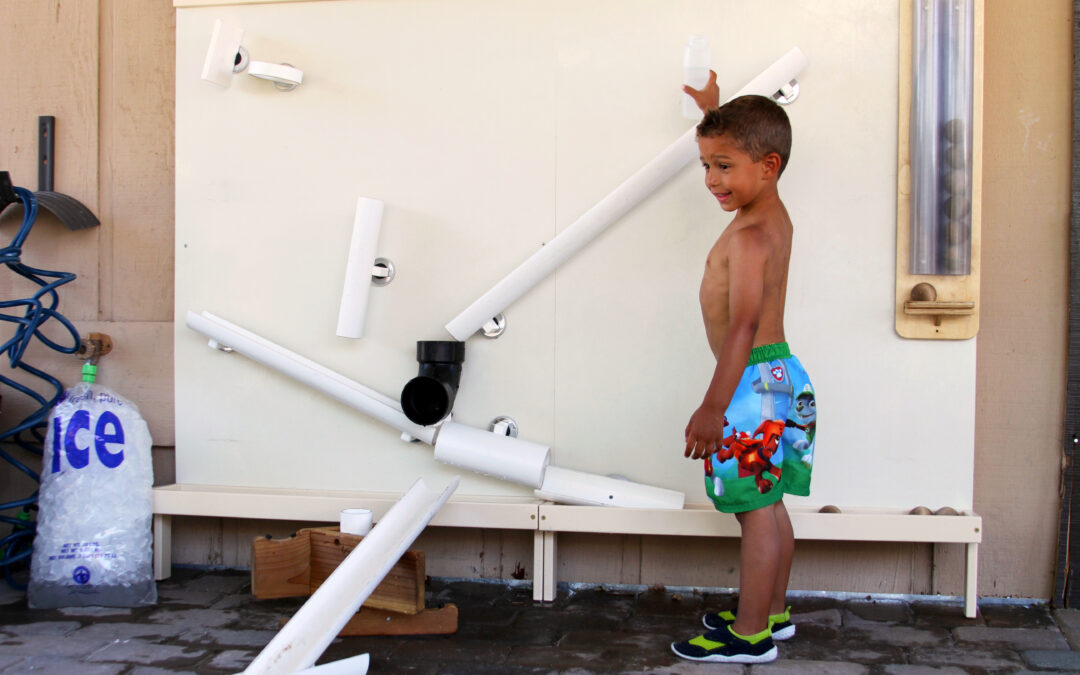We just tried using ice with the Outdoor Mag Wall. It was a perfect opportunity because the kids were moving water from our water pump, along the path to “cool the concrete.” The children are used to using water on the outdoor magnetic wall, so I was able to say to the kids, “I just bought some ice, I wonder what it would look like if we used it on the magnetic wall?”
The kids immediately followed me, because when I have a new idea they always follow! I set the bag of ice next to the magnetic wall and opened it, posing, “I wonder how we could use this ice?” The kids all grabbed a piece and began trying to break them. Many of the kids tried to use the ice like magnets, sticking pieces to the wall and watching them quickly fall. A few tried letting go of the ice a little slower and with more precision to test if that would increase the possibility that the ice would stick. Naturally the ice fell. I said, “Hmmm…when we use balls or water on the magnet wall do they stick?” The kids didn’t answer verbally but immediately began to build a ramp system for conveying the ice down the wall.
Here are some of things the children said during this experience:
- “This is too cold!”
- “Get balls to push ice.”
- “The ball will come on it, then hit the ice…like vrrrrrrr…and it goes down there then the ball pushes the ice.”
- “That’s a great idea, what you just did…. but if you put water where the ice goes it will go all the way down.”
- “The ice is cooling the ground down.”
- “Oh, I got this!”
- “It needs to be elevated.”
- “It’s too high.”
- “Wait, Hudson maked the plan.”
The kids realized that ice was much harder to move than a liquid like water or a solid round object like a ball. They adapted and used materials, those that had reactions and movements they were familiar with, to move the new material.
After about 45 minutes (yes, 45 minutes!) the kids moved to other things, but remained interested with ice and learning about the properties of ice in different environments. “I’m going to see if it melts.” “Yeah, let’s cook it in the sun.” “It’s going to take a while.”
Comments from Diane Spahn, Educational Specialist at Kodo Kids –
Shanna’s introduction of ice was related to the the children’s work of cooling the concrete, which was an appropriate entry point for her to offer a new material with at at least one similar property, in this case, temperature. I wonder how many children made the connection between the temperature of the water they were using and the temperature of the ice they were about to experience.
Shanna’s provoking question, “I wonder how we could use this ice on the magnetic wall”, set up a framework for using a new material in a familiar learning environment, along with familiar materials. Additionally, this question provided enough impetus that an adult did not have to give specific instruction to set the experience in motion. The open-ended opportunity for children and teachers to think in new ways about a known system was implied, leaving room for much experimentation, observation, and teacher facilitation.
When the children attempted to stick the ice to the wall and did not get the results they were expecting, many could have easily given up at that point. Shanna’s reminder of previous experiences in which the children learned that that balls and water don’t stick to the magnetic surface caused them apply prior knowledge to a new situation. This moment of skillful teacher facilitation was both timely and provoking for the children. It caused them to take action, which lead to new discovery and new ways to think about tools they already use.
When the children moved from the mag wall to other outdoor environments they, in fact, extended their own learning. Snippets of their conversations, captured by Shanna, offer the staff insight into the kinds of investigations the children may be interested in pursuing. What other materials could melt or be cooked in the sun? How much time does it take for ice to melt and how can that be measured?
When Shanna introduced the community to ice as a new material, she fueled playful learning for everyone. The experience provided a platform, a leaping off point, for children to uncover new information, apply knowledge, ask questions, and test their theories.
Avenues for adults to broaden and deepen the play can be culled from the raw field notes Shanna captured. Her documentation reveals many physical science and mathematical concepts which were naturally being discussed, questioned, and tested by the children. The NGSS (Next Generation Science Standards) or other learning guidelines could be used to support teachers as they identify and assess children’s knowledge of force and motion, material properties, as well as their growing ability to use logic, and reasoning, comparison and analysis, and more. I wish I could have witnessed, first hand, this delightfully cool (pun intended) experience!
We’d like to thank Shanna White and the Discovery Point community of children and adults for being a part of the Kodo Collaborative and for sharing their story!
Provocation Tip: Ice is a fantastic material with unique and intriguing properties! It certainly proved to be a fantastic medium for play with magnetic ramps on the Outdoor Mag Wall! Don’t have one? Try ice with Kodo’s Outdoor Ramps, your own homemade ramps, or rain gutter system. It’s sure to lead to a super cool, fun, and valuable summer investigation!


